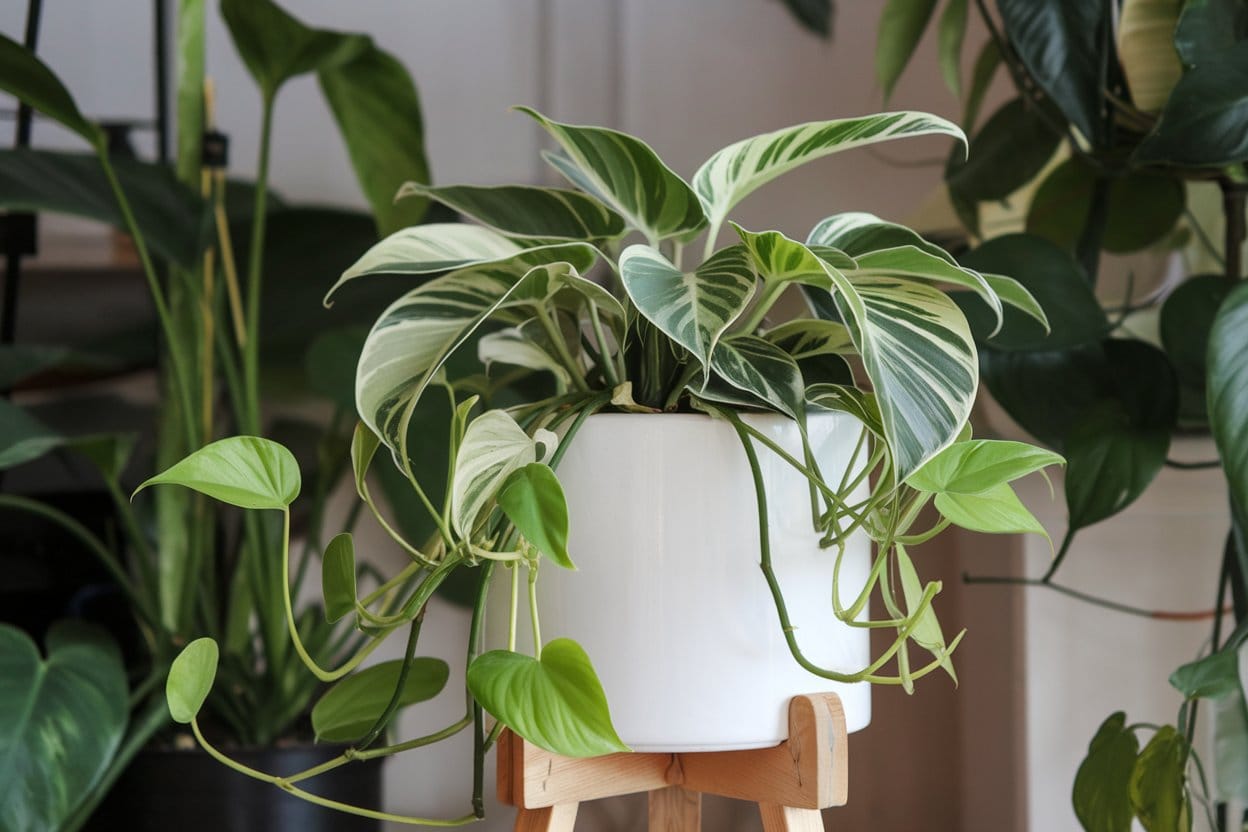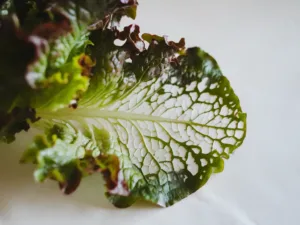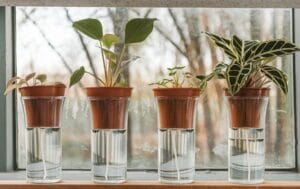Pothos – A Green All-Rounder for Your Home
The Pothos (Epipremnum aureum) is one of the most popular indoor plants, and for good reason! Not only is it incredibly easy to care for, but it also makes a real visual statement. With its glossy, heart-shaped leaves in shades of green, often sprinkled with yellow or white, it brings a touch of fresh greenery to any home. What’s even more exciting is that the Pothos thrives in hydroponics!
Why grow Pothos hydroponically? It’s simple: this growing method offers a clean, hassle-free, and highly effective way to care for indoor plants. Without soil, there are fewer issues with pests, and the plants receive precisely the nutrients they need. Pothos are also known to improve air quality by filtering out toxins like formaldehyde and benzene. A hydroponic Pothos grows vigorously, and you’ll be surprised at how easy it is to provide the best conditions for it!
The Best Pothos Varieties for Hydroponics
Selecting the right variety is essential for success in hydroponics. There are various types of Pothos, each with its own unique features. Here are some of the best varieties suited for hydroponic growth:
- Golden Pothos (Epipremnum aureum ‘Golden’): This is perhaps the most well-known and widespread variety. It’s recognized for its golden-yellow speckled leaves and is incredibly easy to care for. The ‘Golden’ is very hardy and adapts well to different lighting conditions, making it perfect for hydroponic beginners.
- Marble Queen: The ‘Marble Queen’ stands out with its white-marble patterned leaves that brighten up any space. It grows somewhat slower than the ‘Golden Pothos’ but has denser foliage. In hydroponics, it benefits from a stable nutrient supply, which enhances its marbled appearance.
- Neon: As the name suggests, the ‘Neon’ Pothos has bright green, almost neon-yellow leaves that catch the eye. It’s an excellent choice for those looking to add a bit of color to their plant collection. The ‘Neon’ thrives even in less-than-ideal light conditions and shows vigorous growth in hydroponics.
- N’Joy: This variety has smaller, white-and-green variegated leaves. The ‘N’Joy’ is ideal for smaller spaces or where space is limited. It remains compact and fits well in smaller hydroponic systems, such as a glass or vase.
- Cebu Blue: A rarer but very attractive variety, it has elongated, blue-green leaves with a slight metallic sheen. This variety grows quickly and is well-suited for larger hydroponic systems.
With these varieties, you’ll have the best chances of growing a hydroponic Pothos that not only survives but thrives!
Suitable Hydroponic Systems for Pothos
Choosing the right hydroponic system depends on your experience level and available space. Pothos are quite adaptable and grow well in a variety of systems. Here are some of the best options:
- Deep Water Culture (DWC): This system is ideal for beginners, as it’s easy to set up and maintain. The roots of the Pothos hang directly in a chamber filled with nutrient solution, and an air stone provides the necessary oxygen. Pothos thrive here as they have constant access to water and nutrients.
- Nutrient Film Technique (NFT): This system is a bit more advanced and is especially suitable for plants with strong root growth. A thin film of nutrient solution flows continuously over the roots. The Pothos benefits from good oxygenation and optimal nutrient absorption.
- Kratky Method: The Kratky Method is a passive hydroponic system that requires no pump. The plant grows in a container with nutrient solution, and as the water level drops, the roots get both water and air. Perfect for smaller Pothos or if you prefer a simple, low-maintenance setup.
No matter which system you choose, Pothos are robust and adaptable plants that will bring you lots of joy!
How to Start Your Pothos Hydroponically
Growing Pothos in hydroponics is easy and fun. The best way to start is with cuttings that you can easily take yourself.
- Select and Prepare the Cuttings: Choose a healthy stem with at least three to four leaves and cut it just below a node (the area where the leaf meets the stem). Remove the lower leaves to expose the node, which will later develop roots.
- Root the Cuttings: Place the cuttings in a glass of water so that the exposed node is submerged. Position the glass in a bright, indirect sunlight location. Change the water every few days to keep it fresh. After about two to four weeks, you’ll see the first roots!
- Transfer to the Hydroponic System: Once the roots are around 5 cm long, you can place the cuttings in your chosen hydroponic system. Ensure that the roots receive good aeration and consistent nutrient supply.
With this simple method, you can get your hydroponic Pothos setup going in no time!
The Right Substrate for Pothos in Hydroponics
In hydroponics, traditional soil is not used. Instead, specialized materials provide support for the roots while allowing good oxygenation. The best substrates for Pothos include:
- Expanded Clay: Lightweight and reusable, expanded clay offers excellent aeration and drainage. The pellets retain some moisture and are ideal for systems like Deep Water Culture.
- Rockwool: A popular substrate for hydroponic cultivation. It retains moisture well and is easy to handle, though less environmentally friendly.
- Perlite and Vermiculite: These mineral substrates are lightweight, aerate well, and retain moisture. They are particularly well-suited for the Kratky Method or other passive systems.
The choice of substrate depends on your system and personal preferences, but any of these materials will help your Pothos thrive.
Temperature and Humidity: Creating Optimal Conditions
Pothos prefer a warm, tropical climate. The ideal room temperature is between 18 and 27 degrees Celsius. If you live in a cooler environment, consider using a heating mat or lamp.
Humidity should be moderate to high, around 40-60%. If the air is too dry, a humidifier or regular misting of the leaves can help. Avoid placing the plant near heaters or air conditioners, as they can dry out the air too much.
Light Requirements for Pothos in Hydroponics
Pothos are true survivors when it comes to light. They prefer bright, indirect light but can also thrive in lower light. If your Pothos is in a darker spot, you can supplement it with an LED grow light.
Make sure the lamp is on for about 12-16 hours per day to simulate natural sunlight. Too much direct sunlight can burn the leaves, while too little light slows growth. A good balance promotes strong, healthy plants.
pH and EC: The Ideal Nutrient Solution for Pothos
A slightly acidic pH is ideal for Pothos. The optimal range is between 5.5 and 6.5. A pH level that is too high or too low can inhibit nutrient absorption and stunt growth.
The electrical conductivity (EC) should be between 1.0 and 1.8. Regular testing and adjusting of the nutrient solution is important to ensure your plant has the best growing conditions.
Diseases and Pests: Keeping Your Pothos Healthy
While hydroponics reduces pest issues, Pothos are not completely immune. Common problems include:
- Aphids and Spider Mites: These can be controlled with a mild soap solution or neem oil.
- Root Rot: This can occur if water is stagnant or roots don’t get enough oxygen. Regularly checking the roots and nutrient solution helps prevent this.
- Powdery Mildew: A fungus that appears as white, powdery spots on leaves. Good air circulation and adjusted humidity can help prevent it.
Plant-Specific Tips: Getting the Most Out of Your Pothos
Pothos are easy to propagate. Simply cut a healthy stem and start the process again! Regular pruning also encourages bushier growth and prevents the plant from becoming too long and sparse.
If you want to hang your Pothos or place it on a shelf, make sure the trailing vines have enough space and aren’t constantly moved to avoid damage.
Pothos in Hydroponics – Easy Green Splendor
Pothos is a low-maintenance and adaptable plant, perfect for hydroponic cultivation. With the right varieties, the suitable system, and a little care, you can create a green oasis that not only looks great but also improves the air quality in your home. Start your own hydroponic Pothos today and enjoy healthy growth!







